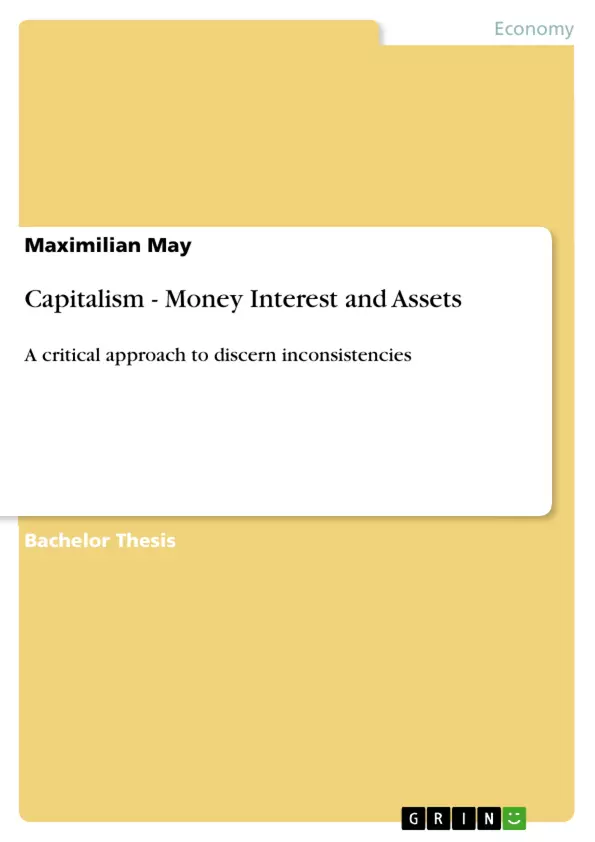The bachelor thesis has been written in an attempt to combine knowledge about economic interdependencies and the commonly unknown economic view of free economists (,Freiwirtschaft‘) including the following:
Various economic views reaching from Mercantilism to Keynesian economics and Monetarism to present a basis for further evaluation of the topic (,Literature Review‘ Chapter 1)
Chapter 2 dealt with basic economic rules, e.g. the non-accelerating inflation rate of unemployment (NAIRU) in an attempt to prove the prevalence of unemployment, inflation and others in modern economies
Money and its various, partially contradictory definitions, interest and compound interest and growing financial assets (vs. real economy) regarding the latest financial crisis (Chapter 3)
Besides quantitative textbook research in chapters 1 to 3, chapter 4 includes personally conducted qualitative research asking members of the free economists‘ movement for some of the basic consequences that emerge from the currently running capitalistic economic system:
Societal tensions within industrialised countries (growing gap between rich and poor)
The connection between environmental abuse and capitalism
Growing national debts (which is currently big in the news =)
The industrialised world vs. developing and third world countries
Reasons for financial crises and business cycles in general
What does not become clear from the above is the author‘s belief in the founder of the Freiwirtschaft Silvio Gesell and that his view of the matter played a leading role throughout the thesis. In an attempt to analyze and synthesize the economic world order and to then compare it to the free economists view to prove the current instabilities and to give an alternative to the current system.
The findings of the thesis can be summarized as follows:
A demurrage on money is needed to break the downward rigidity of interest rates
This, in turn, would increase the velocity of money
Which could lead to the abolishment of price instability
Which could - depending on the marketplace - abolish unemployment
Generally, the marketplace in any economy could eventually respond to reality, e.g. a saturated market has a negative growth, so the financial assets are able to lose in value correspondingly.
Inhaltsverzeichnis (Table of Contents)
- Abstract
- Acknowledgements
- Background
- Introduction
- Methodology
- Chapter 1
- Literature Review with the Macro-facts
- Mercantilism
- Physiocracy
- Classical Economics
- Say's Law
- Neoclassic and Marginalist School
- Marxist School
- Keynesian Economics
- The theory of Keynes
- The theoretical framework of Keynes theory
- Monetarism
- Equation of exchange and velocity of money
- The quantity theory of money and prices
- Towards the end of Chapter 1
- Inflation vs. Deflation
- The Phillips Curve
- Chapter 2
- Some evidence for microeconomic inefficiencies
- Unemployment, Price (in)stability and Business cycles
- The non-accelerating inflation rate of unemployment (NAIRU)
- Chapter 3
- The 'Free' Analysis for the prevalence of inefficiencies
- The investment decision
- Money and its different definitions
- What happens if money fails to deliver one of these functions?
- Interest and Compound Interest
- Growing Financial Assets
- Chapter 4
- An evaluation of macroeconomic consequences
- Growing societal pressures
- The 'Story of Stuff'
- Governments and their debts
- Capitalistic, shifting and non-capitalistic economies
- The current financial crisis and business cycles
- The Discussion
- Some ideas for the future
Zielsetzung und Themenschwerpunkte (Objectives and Key Themes)
The dissertation aims to demonstrate the prevalence of inconsistencies within the macroeconomic framework and analyze these shortcomings using secondary research. It seeks to identify inherent problems in the integration of capitalism into the macroeconomic framework and the forces that contribute to inconsistencies, drawing on both secondary and primary research. The work concludes with recommendations for improving the current state of affairs.
- Inconsistencies in the Macroeconomic Framework
- Integration of Capitalism into Macroeconomics
- Forces Contributing to Inconsistencies
- Free-Economy Approach and its Contributions
- Practical Implications for Improvement
Zusammenfassung der Kapitel (Chapter Summaries)
Chapter 1 delves into the literature review, examining both mainstream and non-mainstream economic schools of thought, with an emphasis on the free-economy approach. It explores various economic schools, including Mercantilism, Physiocracy, Classical Economics, Say's Law, Neoclassical and Marginalist School, Marxist School, Keynesian Economics, and Monetarism. Chapter 2 presents evidence for microeconomic inefficiencies, focusing on unemployment, price (in)stability, and business cycles, including the concept of the non-accelerating inflation rate of unemployment (NAIRU). Chapter 3 examines the 'Free' Analysis for the prevalence of inefficiencies, covering topics such as the investment decision, the functions of money, the impact of money failure, interest and compound interest, and growing financial assets. Chapter 4 evaluates macroeconomic consequences, discussing growing societal pressures, the 'Story of Stuff', government debt, capitalistic and non-capitalistic economies, the current financial crisis, and business cycles.
Schlüsselwörter (Keywords)
Key terms and concepts explored in this dissertation include: capitalism, macroeconomic framework, inconsistencies, free-economy approach, economic schools of thought, microeconomic inefficiencies, unemployment, price stability, business cycles, investment decision, functions of money, interest, compound interest, financial assets, societal pressures, government debt, financial crisis, and business cycles.
- Quote paper
- Maximilian May (Author), 2009, Capitalism - Money Interest and Assets, Munich, GRIN Verlag, https://www.grin.com/document/177463



